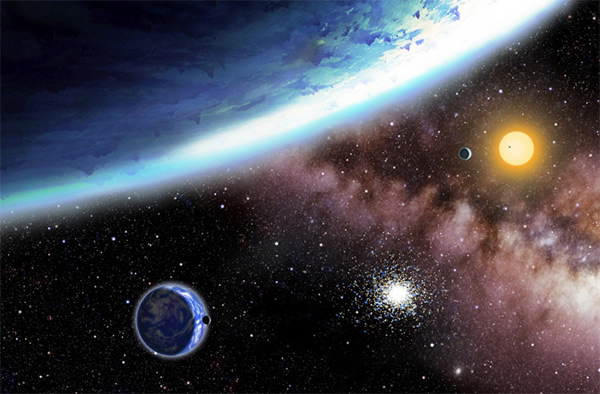Kepler-62: A Star System With Two Earths?
About 1,200 light-years from Earth, five planets are circling around a sun-like star in the constellation Lyra, two of which are fortuitously positioned for water, if any exists, to remain liquid on their surfaces, a condition believed to be necessary for life.
The discovery, made by scientists using NASA’s planet-hunting Kepler space telescope, is the strongest evidence yet for more than one Earth-sized planet existing in a star’s so-called “habitable” zone.
“We’re particularly delighted to find that there are two planets in the habitable zone,” lead Kepler scientist William Borucki, with NASA’s Ames Research Center in California, told Discovery News.
“It sort of doubles our chances of finding that Earth we’d all like to find. When you think about Earth and Mars, if Mars had been a bit larger, if Jupiter hadn’t been so close, we’d again have two planets in the habitable zone and maybe we’d have a place to go,” he said.
Artist's impression of the five-planet Kepler-62 system, with two worlds in the habitable zone -- the distance from their star at which they receive enough light and warmth for liquid water to theoretically exist on their surfaces.
The newly found planets are the outermost pair circling a star known as Kepler-62.
The most distant planet, Kepler-62f, is about 1.4 times as big as Earth and orbits its parent star in 267 days.
“It was a surprise,” University of Washington astronomer Eric Agol told Discovery News. “It was a fairly immediate realization that this planet was potentially suited to have liquid surface water.”
The other planet, Kepler-62e, is 1.6 times Earth’s size and circles its star in 122 days.
Whether either or both of Kepler-62’s optimally positioned planets actually has water is beyond the technical capabilities of the Kepler and other telescopes. Kepler works by detecting the very slight dips in light coming from a star caused by a planet passing by, relative to the telescope’s line of sight.
Sifting through the information is a painstaking and long process. Every download of data from Kepler includes about 18,000 events of potential interest to scientists.
“We have at any given time thousands of candidate planets,” Borucki said. “You pick one, you spend a lot of time and a lot of ground-based telescope effort to make sure it couldn’t be anything else. All the possibilities have to be eliminated.”
Scientists are not yet finished with Kepler-62. The observatory hasn’t been operating long enough to find and confirm the transits of any planets with longer orbital periods.
“I wouldn’t at all be surprised if we find another one, or maybe two or three,” Borucki said.
The Kepler team previously discovered a star with six planets in orbit, while a group of European researchers using a different telescope and technique, have found a seven-planet system.(Apr 18, 2013 02:00 PM ET // by Irene Klotz )












